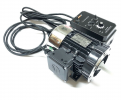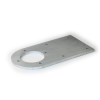This is the Beaumont disk grinder. Nice, but pricey.
View attachment 1819018
You can make something that works yourself from a $30 piece of aluminum plate, a $50 motor, and a $100VFD ... plus a disc.
You can make the identical unit for 1/2 the price using Rob's base plate and a disc, plus a motor/VFD package from Ebay
View attachment 1819031
View attachment 1819033
This would be the route that I would take If i end up making it. Not sure how how practical or possible for crossing using my 2x72 motor and VFD since I roll my grinder outside to use just because of my shop not really being a shop lol. But I do wonder with buying a cheaper motor and homemade mount how much shake/vibrations does something like this have while running? Would I be able to get away with putting it on a smaller steel table to move around or would I need to bolt this to the floor or my workbench?





